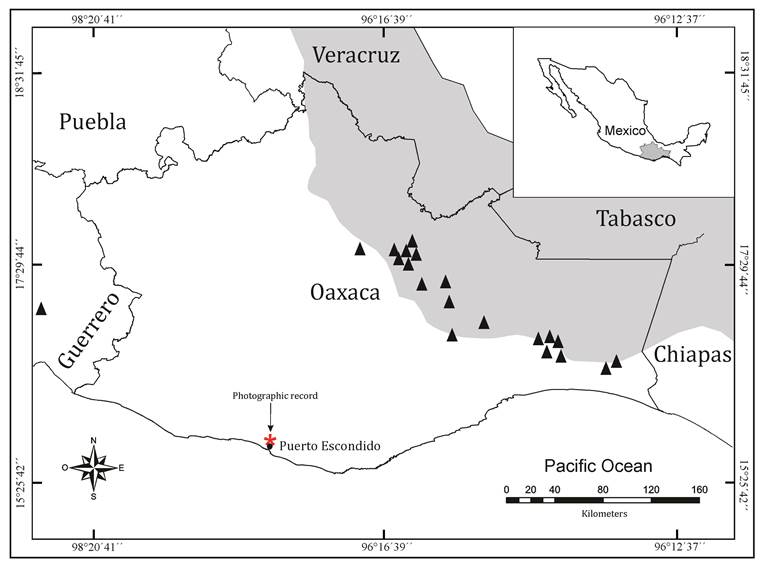The Blue-gray Tanager (Thraupis episcopus) is a neotropical resident species with known distribution from eastern Mexico through Central America, Colombia, Venezuela, northern Bolivia, eastern Peru and the center of Brazil, and in the Caribbean region in Trinidad and Tobago (Miller et al., 1957; Dickinson, 2003; Clements, 2007; Schulenberg et al., 2007; Hilty, 2016). In Mexico, it is widely distributed in geographical areas from sea level up to 1,500 m (Howell & Webb, 1995) in the states of the center-south, including Nuevo León, Tamaulipas, San Luis Potosí, Hidalgo, Puebla, Veracruz, northern and southern Oaxaca, Tabasco, Campeche and Quintana Roo (Navarro-Sigüenza et al., 2004; Navarro-Sigüenza & Peterson, 2007; Monroy Ojeda & Grosselet, 2008). This neotropical bird prefers open and semi-open areas, crops, gardens on the outskirts of cities, parks and squares (Howell & Webb 1995; Silva et al., 1996).
In the systematic list of birds from Oaxaca State, Navarro-Sigüenza et al., (2004) considered the Blue gray Tanager in the Atlantic and Oaxaca´s central valleys. The most recent accounts of birds in the central coastal plain (Bojorges-Baños, 2008; 2011a; 2011b; Germain & Ruiz-Bruce, 2016) not include the presence of this species in this region. However, two recent unpublished records on the distribution of this species in Oaxaca (AverAves/Naturalista electronic platform) have been documented, one in La Crucecita, Huatulco on July 22, 2017, and another in Puerto Escondido on May 26, 2017; both records lack geographic location. Therefore, in this work we present a recent photographic record of the Blue-gray Tanager (T. episcopus) in an urban environment on the central coast of Oaxaca, Mexico.
On September 26, 2017 at 09:16, a couple of individuals of Thraupis episcopus were found in the main parking lot (15º 53' 20.63" N, 97º 04' 40.56" W) of the Universidad del Mar, campus Puerto Escondido (Fig. 1), where eight photographs were taken toof one of them (Fig. 2). The female specimen was observed among the foliage and flowers of a guamuchil tree (Pithecellobium dulce), and the identification was made with different field guides (Howell & Webb 1995; Peterson & Chalif, 1998; Van Perlo, 2006).

Figure 1 Location of photographic record of Thraupis episcopus (red asterisk) in Puerto Escondido, Oaxaca; and historic published records (black triangles) in the state. The gray shade represents the potential distribution of this species based on Navarro-Sigüenza and Peterson (2007).

Figure 2 Photographic record of Thraupis episcopus in Puerto Escondido, San Pedro Mixtepec Municipality, Oaxaca.
The coloration of plumage for females and juveniles of Blue-gray Tanager is blue-gray are a dull blue overall (Howell & Webb, 1995; Peterson & Chalif, 1998; Van Perlo, 2006). The record presented here confirms the presence of the Blue-gray Tanager in areas that lack previous published records (Sánchez-González, 2013); furthermore, similar records in Guerrero (Blancas Calva et al., 2017) and the Yucatan Peninsula (Rodríguez-Ruíz et al., 2011) have been related to the expansion of range of this species due to the presence of human altered habitats that promote the establishment of bird populations in new areas (Castro-Torreblanca & Blancas-Calva, 2014).
Puerto Escondido is located on the central coast of Oaxaca, and our photographic records confirm the presence of this species (Sánchez-González, 2013), but this punctual record should be considered as unusual for this area unless more records are documented in intermediate areas.
Probably, there has been successful dispersal due to climatological events, such as hurricanes, cyclones, and tropical storms (Blancas-Calva et al., 2017). In our case, the climatological events in recent past years (Carlota and Ernest hurricanes, 2012) could have influenced in the enlargement of the distribution of this species.
Finally, it is of utmost importance to recognize sites where this species has been reported to contribute to the analysis of trends in the enlargement of the distribution area of neotropical birds and the possible causes of these possible episodes of dispersion.











 text new page (beta)
text new page (beta)


